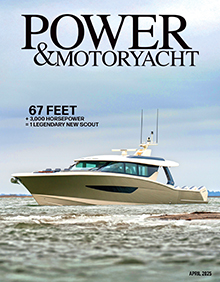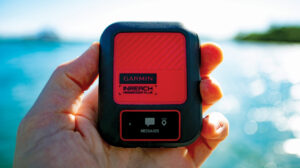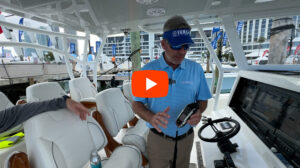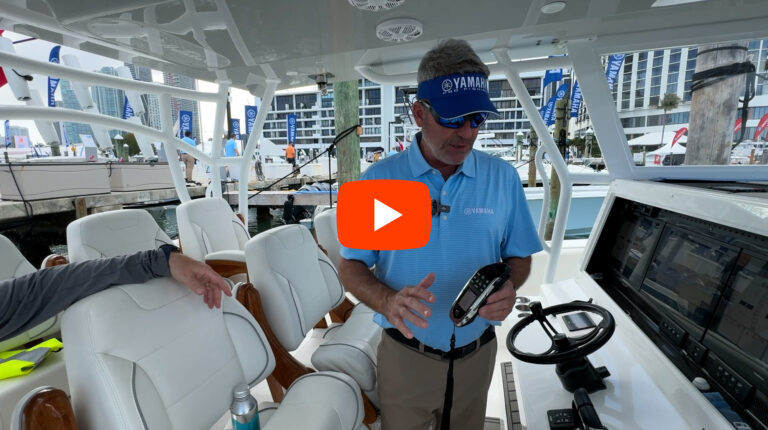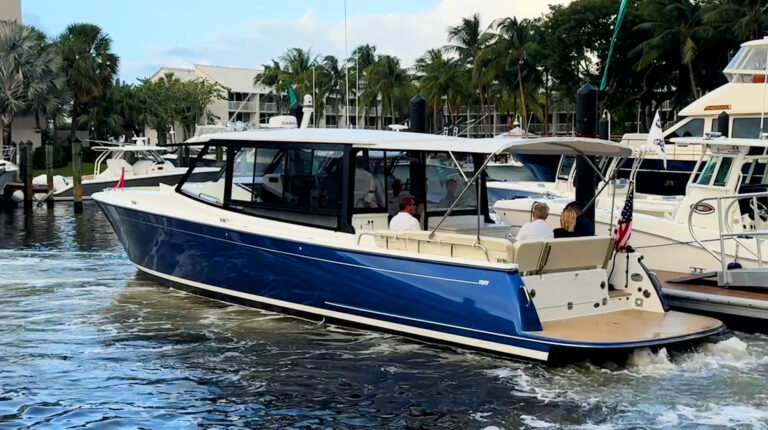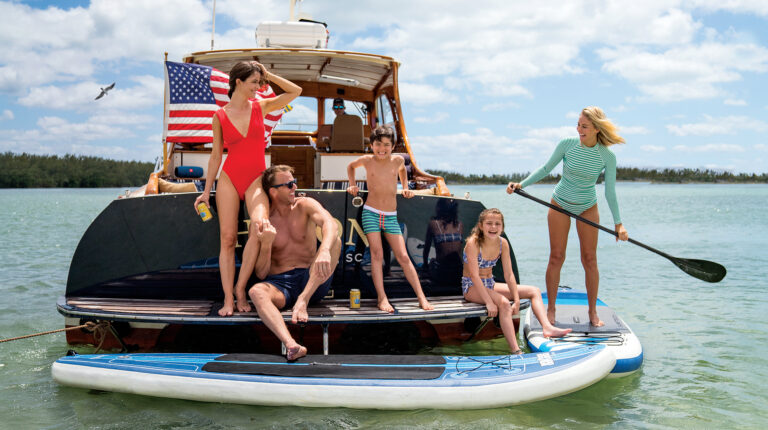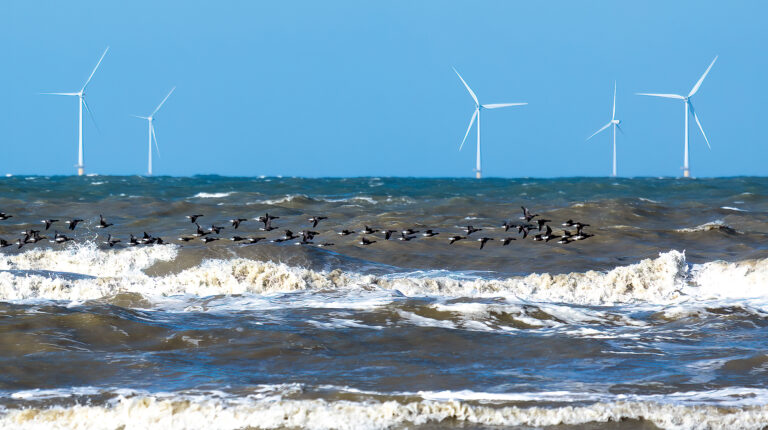Knowledge Is Power
Distributed electrical systems add value to your breaker board and make it easier to use.
Think about the location of your boat’s batteries. Now think about where your engine-room ventilation fans are. Of course, the distance separating them varies from boat to boat but I’ll lay odds that in most cases they are within about 15 feet of each other.

But in what could be called a “conventional” power-distribution system, there are usually one or two big distribution boards somewhere in the saloon or wheelhouse receiving power from the batteries through two massively thick cables. Inside the distribution board the power flows through solid copper bus bars that distribute it to the circuit breakers—maybe 100 or more of them. From each circuit breaker, thinner cables carry the power out to individual “consumers” such as lights and pumps—usually, but not necessarily passing through some kind of switch on the way.
So getting power from the batteries to fans that are ten feet away may well involve anywhere from 60 to 100 feet of wire, from the battery to the breaker, from the breaker to the switch, and from the switch to the blower. Multiply that situation by the number of pumps, fans, lights, and motors onboard, and on a 60-foot boat, you could be talking about as much as a ton of wire.
One way to cut down on the weight and power wasted in all these long cable runs would be to give up the extravagant practice of providing every piece of equipment with its own private two-wire connection to the main distribution board.
Or you could have several smaller distribution boards: one in the engine room, one in the wheelhouse, and maybe one in each cabin. That would eliminate the need for cables carrying power from the wheelhouse to the engine room, for a start.

With less power flowing through the wheelhouse distribution board, it wouldn’t need to be supplied through such thick cables. And as most 12-volt system cables have to be oversized in order to reduce the voltage drop over long runs, reducing the length of cable used might allow the cable size to be reduced even more.
Technically, decentralizing the electrical system—often known as “distributed power”—has a lot to recommend it. The big thing against it was us—boaters. We like to switch things on and off from the wheelhouse and have grown to love those huge, industrial-looking distribution boards.
But there have always been some pieces of equipment whose demands for power are so heavy that we’ve had no choice. It is simply impractical to route the power cables for a windlass or bow thruster up to a distribution board in the wheelhouse, up to a switch on the flying bridge, and then back down to the foredeck or to a space under the forward cabin. Instead, these high-power users usually do have their own completely separate power supplies, with individual circuit breakers and contactors (remote-controlled switches) mounted on or close to the equipment itself. What appears to be a switch in the wheelhouse or flying bridge is really a hard-wired remote control.
Of course, there’s no reason why the remote-control principle shouldn’t apply to a circuit breaker: There’s no real reason to have all the circuit breakers in the wheelhouse when you could have some in the forward cabin, some in the galley, and some in the engine room, all remotely controlled from the wheelhouse—except that until a few years ago there wouldn’t have been much point. It would probably have added more weight and complexity than it could save.
But then a handful of companies started developing solid-state circuit breakers that could be remotely controlled by a computer, with control signals sent through a communications network such as NMEA 2000. Systems such as OctoPlex, CZone, Capi2, and others combine the technical efficiency of a distributed power system with the convenience of centralized control.
The funny thing is that the communications side of such a system can do much more than just switch circuit breakers on and off. So for many people, the original purpose of a distributed power system—saving weight, wire, and waste—is now secondary to its other benefits. “We estimate a weight reduction of cabling between 30 and 50 percent,” says Tijmen Harberink, operational manager of Capi2.
But Paul Holland, managing director of Energy Solutions, told me that for his company, weight savings is less important than the control and monitoring opportunities it offers. “I would regard the technology as being an assistant to saving weight when absolutely necessary,” he says. The big control enhancement is that the captain doesn’t have to remember which circuit breakers to switch on or off to adapt his boat’s systems to different situations.
Most distributed electrical systems include a central control unit that can be programmed to switch on the right breakers for each of several standard operating modes such as “underway,” “anchored,” or “marina.” Some also allow for automatic load-shedding, so that if the battery charge starts to drop uncomfortably low, the system will automatically conserve power by switching off the least important services.
Another neat feature—part of the enhanced monitoring—is that electrical information can be displayed alongside information from completely different sensors. You might, for instance, have gauges showing the levels in your gray-water and black-water tanks displayed on the same touchscreen as the breakers that control the supplies to the pumps; some systems take this a step further and incorporate an automatic shut-down function to cut the power to the shower pumps when the gray-waste tank is full.
“Monitoring” merges into diagnostics. In a conventional system, you may know when too much current is flowing in a particular circuit because you can see that its breaker has tripped. But a digital distribution board can also tell you when a piece of equipment is drawing less power than it should—perhaps indicating that a motor isn’t actually running even though it has been turned on.
And then there’s the cosmetic angle—the range of options open to designers who can choose anything from a tucked-away control panel the size of a small chart plotter to an imposing Star Wars console replete with gauges, colored lights, and animated schematics. It’s even possible to dispense with the dedicated electrical panel altogether and control and monitor your electrical system on your multifunction display or even on your smartphone.
CAPI2
(+31) 40 284 7001.
www.capi2.com.
Czone
(800) 307-6702.
www.bepmarine.com.
E-Plex
(+44) 1634 778704.
www.e-plex.co.
Energy Solutions
(+44) 1634 290772.
www.energy-solutions.co.uk.
Octoplex
(215) 996-9211.
www.moritzaero.com.
This article originally appeared in the April 2012 issue of Power & Motoryacht magazine.

